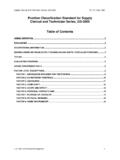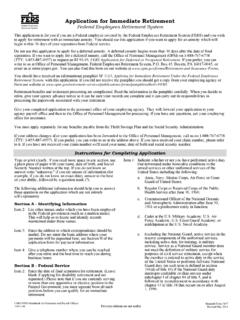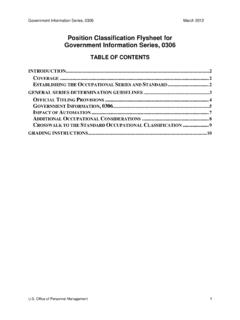Transcription of Learning and Knowledge Sharing Strategy - opm.gov
1 CIO-01598-06 United StateSOffice Of PerSOnnel ManageMentChief Information Officer1900 E Street, NWWashington, DC 20415 June 2011 Learning and Knowledge Sharing Strategy Ver sion OPM Learning and Knowledge Sharing Strategy i EXECUTIVE SUMMARY The Learning and Knowledge Sharing Strategy (LKSS) describes OPM s vision to become America s model employer for the 21st Century and fulfill its mission of recruiting, retaining and honoring an excellent workforce to serve the American people. Through the LKSS, we will: Establish a sustainable culture of Learning and collaboration by primarily focusing on OPM s people and processes.
2 We will start making this cultural shift by establishing communities of practice (CoPs) that use action Learning to solve organizational problems and spread innovation. Stand up Knowledge Sharing tools as they come to be needed to support the CoPs instead of starting with a solution. Tie communities of practice to succession planning and the urgent need to capture the Knowledge of departing highly skilled OPM employees. Combine OPM s intranet Theo and external web site into an easily expandable, collaborative Knowledge Sharing platform.
3 Measure the effectiveness of the LKSS in both transforming OPM and fulfilling the agency s strategic goals. The LKSS flows from the Open Culture Plan and the Communication and Collaboration Strategy in that their shared goals fulfill the objectives of OPM s Strategic Plan to bring openness, transparency, and collaboration to the agency for the benefit of employees and the American public that we serve. OPM Learning and Knowledge Sharing Strategy ii TABLE OF CONTENTS EXECUTIVE SUMMARY .. i 1 INTRODUCTION.
4 1 About This Document .. 1 Knowledge Management .. 1 How Knowledge Sharing Supports OPM s Strategic Plan .. 2 Background of the Open Government Team and the Flagship Initiative .. 3 Culture Plan Summary .. 4 Communication and Collaboration Plan Summary .. 5 2 WHAT IS Knowledge Sharing ? .. 5 Explicit and Tacit Knowledge .. 6 Strategy for Enterprise-Wide Knowledge Sharing .. 7 OPM s Current Knowledge Management/ Sharing Maturity Level .. 8 Organizational Structure .. 9 3 COMMUNITIES OF PRACTICE.
5 10 Process for Creating and Growing CoPs .. 10 Action Learning and Communities of Practice .. 12 4 SUCCESSION PLANNING .. 13 5 Knowledge Sharing TECHNOLOGY .. 14 THEO .. 14 FAQs .. 15 Enhanced Directory .. 15 Document Management and Records Management .. 15 Learning Connection .. 15 Idea Factory .. 16 Mentor Connect .. 16 Content Management .. 16 Business Analytics and Process Intelligence .. 16 OPM Learning and Knowledge Sharing Strategy iii Collaboration Platform for CoPs.
6 17 6 MEASURING Knowledge MANAGEMENT .. 17 7 MARKETING THE Knowledge Sharing PROGRAM .. 18 8 CONCLUSION .. 19 9 REFERENCES .. 21 APPENDIX 2006 SURVEY OF OPM KEY Knowledge AREAS AND KM STRATEGIES .. 22 OPM Learning and Knowledge Sharing Strategy iv List of Tables Table 1: Mapping OPM's Strategic Goals to the LKSS .. 2 Table 3: Marketing Activity Matrix .. 19 OPM Learning and Knowledge Sharing Strategy v List of Figures Figure 1: Open Government Governance Structure .. 3 Figure 2: Converting Tacit Knowledge into Explicit.
7 7 Figure 3: Knowledge Management Maturity Model .. 9 Figure 4: Supporting CoPs with a Collaboration Platform .. 12 OPM Learning and Knowledge Sharing Strategy 1 1 INTRODUCTION About This Document This document describes OPM s Learning and Knowledge Sharing Strategy (LKSS). The purpose of the LKSS is to describe Knowledge Sharing and recommend activities that will create a Learning and collaborative culture within OPM and with external stakeholders. We also discuss the supporting activities of succession planning, change management, performance management, Knowledge Sharing metrics, and marketing Knowledge management.
8 To realize the principles of Open Government, we need to support a culture that values and encourages Learning and collaboration across all levels within OPM and with all of our stakeholders. OPM is unique in that we influence almost every Federal agency and impact American citizens simultaneously. Through the recommendations in this Strategy , we can better engage our stakeholders by becoming more transparent, participatory, and collaborative through the continuous development and improvement of OPM s employees and processes.
9 Knowledge Management Knowledge management (KM) facilitates the processes by which Knowledge is created, shared and used in organizations. It is not necessarily about making major investments in technology and sophisticated software applications, or establishing a new office to oversee organizational KM efforts, or managing all Knowledge . It is about managing the Knowledge that is most important to the organization and using that Knowledge in ways that allow employees to work smarter, resulting in production and/or quality improvements throughout the organization.
10 There are many ways of looking at KM and different organizations will take different approaches. Creating a Knowledge environment usually requires changing organizational values and culture, adapting individual employees behaviors and work patterns, and providing people with easy access to each other and to relevant information resources. By establishing communities of practice (CoPs), people who share a passion and/or interest will be able to come together in a community to solve problems, learn from one another, and create new Knowledge .















